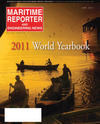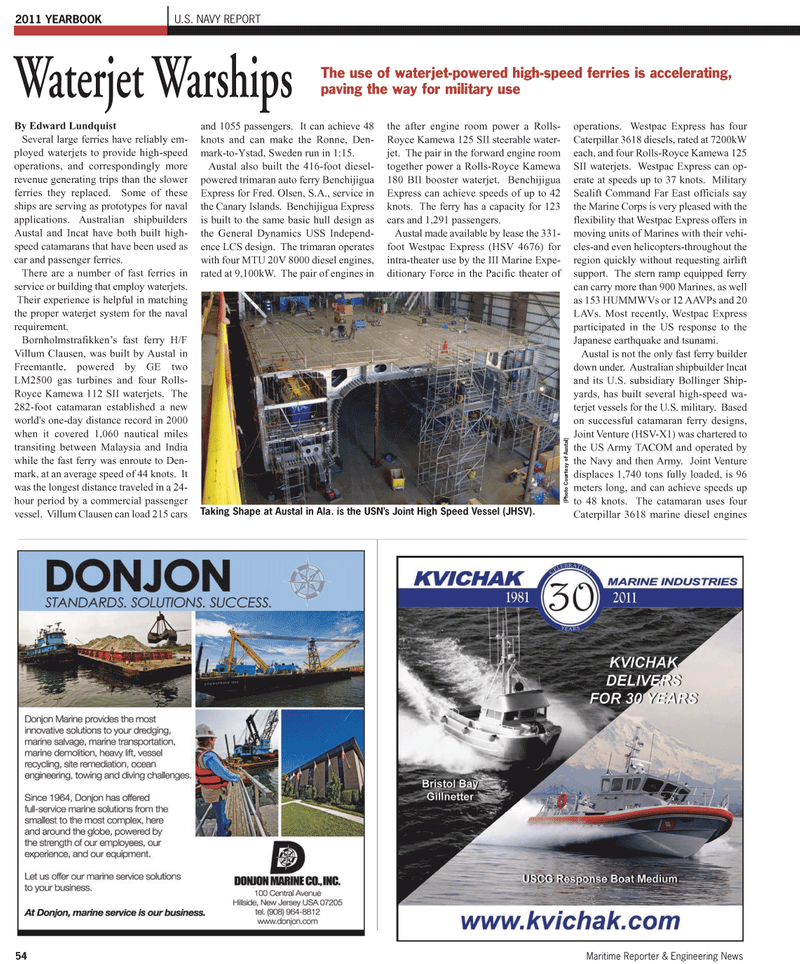
Page 58: of Maritime Reporter Magazine (June 2011)
Feature: Annual World Yearbook
Read this page in Pdf, Flash or Html5 edition of June 2011 Maritime Reporter Magazine
54Maritime Reporter & Engineering News 2011 YEARBOOKU.S. NAVY REPORT By Edward Lundquist Several large ferries have reliably em- ployed waterjets to provide high-speed operations, and correspondingly morerevenue generating trips than the slower ferries they replaced. Some of these ships are serving as prototypes for naval applications. Australian shipbuilders Austal and Incat have both built high- speed catamarans that have been used as car and passenger ferries. There are a number of fast ferries in service or building that employ waterjets. Their experience is helpful in matching the proper waterjet system for the naval requirement.Bornholmstrafikkens fast ferry H/F Villum Clausen, was built by Austal in Freemantle, powered by GE two LM2500 gas turbines and four Rolls-Royce Kamewa 112 SII waterjets. The 282-foot catamaran established a new world's one-day distance record in 2000 when it covered 1,060 nautical miles transiting between Malaysia and Indiawhile the fast ferry was enroute to Den- mark, at an average speed of 44 knots. It was the longest distance traveled in a 24- hour period by a commercial passengervessel. Villum Clausen can load 215 cars and 1055 passengers. It can achieve 48 knots and can make the Ronne, Den- mark-to-Ystad, Sweden run in 1:15.Austal also built the 416-foot diesel- powered trimaran auto ferry Benchijigua Express for Fred. Olsen, S.A., service inthe Canary Islands. Benchijigua Express is built to the same basic hull design as the General Dynamics USS Independ-ence LCS design. The trimaran operates with four MTU 20V 8000 diesel engines,rated at 9,100kW. The pair of engines in the after engine room power a Rolls- Royce Kamewa 125 SII steerable water- jet. The pair in the forward engine room together power a Rolls-Royce Kamewa 180 BII booster waterjet. Benchijigua Express can achieve speeds of up to 42 knots. The ferry has a capacity for 123 cars and 1,291 passengers.Austal made available by lease the 331- foot Westpac Express (HSV 4676) for intra-theater use by the III Marine Expe-ditionary Force in the Pacific theater of operations. Westpac Express has four Caterpillar 3618 diesels, rated at 7200kWeach, and four Rolls-Royce Kamewa 125 SII waterjets. Westpac Express can op- erate at speeds up to 37 knots. Military Sealift Command Far East officials say the Marine Corps is very pleased with the flexibility that Westpac Express offers in moving units of Marines with their vehi- cles-and even helicopters-throughout the region quickly without requesting airlift support. The stern ramp equipped ferry can carry more than 900 Marines, as wellas 153 HUMMWVs or 12 AAVPs and 20 LAVs. Most recently, Westpac Express participated in the US response to theJapanese earthquake and tsunami. Austal is not the only fast ferry builder down under. Australian shipbuilder Incat and its U.S. subsidiary Bollinger Ship-yards, has built several high-speed wa- terjet vessels for the U.S. military. Based on successful catamaran ferry designs,Joint Venture (HSV-X1) was chartered to the US Army TACOM and operated by the Navy and then Army. Joint Venture displaces 1,740 tons fully loaded, is 96meters long, and can achieve speeds up to 48 knots. The catamaran uses four Caterpillar 3618 marine diesel enginesWaterjet Warships The use of waterjet-powered high-speed ferries is accelerating, paving the way for military useTaking Shape at Austal in Ala. is the USNs Joint High Speed Vessel (JHSV). (Photo Courtesy of Austal)

 57
57

 59
59
